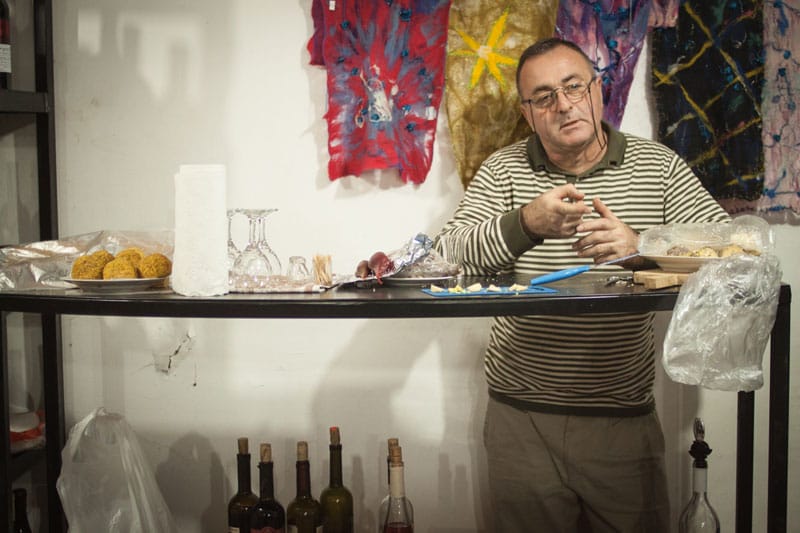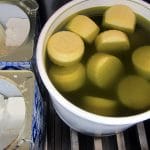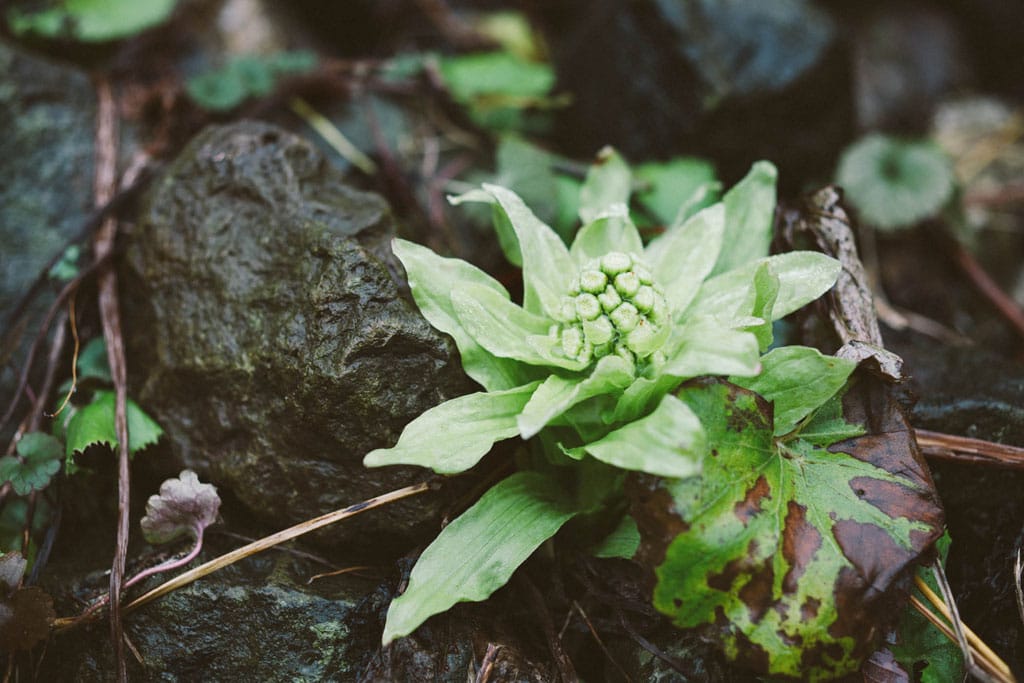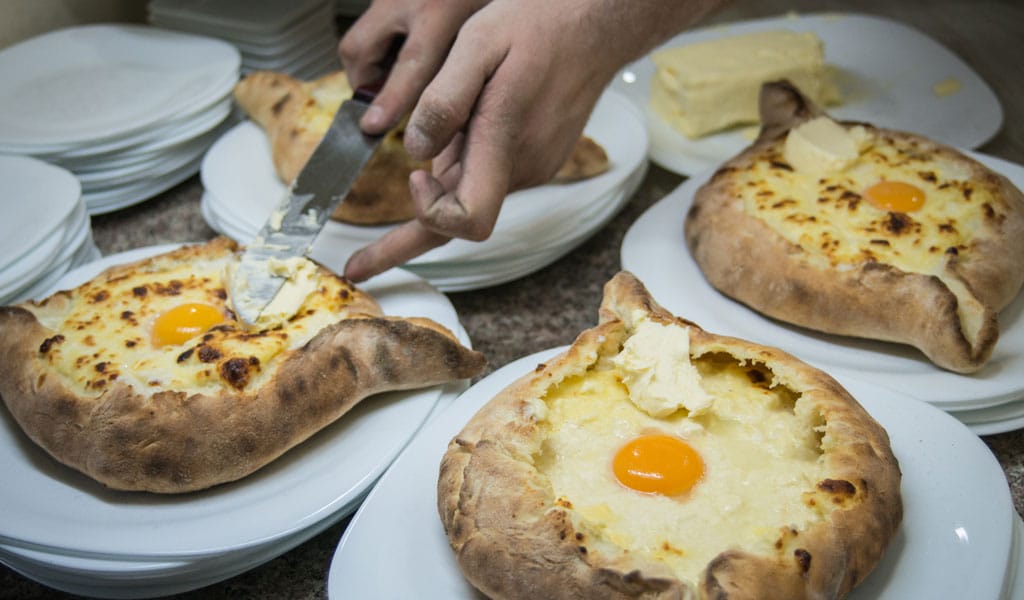We’ve seen the doleful little building a hundred times, every time we cross Tbilisi’s Dry Bridge. With the seductive words chacha, grappa and vino hand-painted on the wall enticing us like a red-light district lures lonely sailors, we would move on, thinking, “one of these days.”
Then one sweltering summer night our band got a gig at the biker bar next door to the sad little building. We had a half-hour to kill until show time, and we thought, surely, one shot won’t hurt. But instead of walking into a moonshine dispensary we found a little tourist shop packed with wine, ceramic vessels and assorted knick-knacks. The real discovery, however, were three refrigerators stocked with balls of craft cheeses.
“Want to try some cheese?” Bagrati Mezurnishvili asked in English.
Georgia is a country that loves its cheese, yet only three basic varieties are mass produced. Guda is a pungent mountain cheese, sharp as a hunting knife. It is typically made from sheep’s milk and aged in sheep stomachs and skins. Imeruli is a soft, squeaky cow’s milk cheese from Imereti. Sulguni is a pasta filata-type cheese often compared to mozzarella. In addition to these are cottage cheeses like khacho and nadugi. There are dozens more native to regions and villages that take quite an effort to find in Tbilisi, like dadmbalkhacho, a hard, zesty, blue cheese from Tianeti that UNESCO has added to its List of the Intangible Cultural Heritage of Humanity.
Bagrati took out a plate with over a half dozen nibble-sized samples of his cheese. “This is number one,” he said, pushing it over with his knife. It had a slightly nutty flavor, kind of like a Gruyère and then, totally not. It was hard to compare this snowball-shaped cheese to anything other than the other types he sold, all of which are based on a traditional family recipe that skipped a generation.
“My father was a communist. He loved Stalin. But my grandfather was a capitalist. He made this cheese secretly. They would have put him in prison if they had caught him,” Bagrati explained.

Bagrati’s own path to cheese making took a circuitous course. As a child, he helped his grandfather make cheese but then joined the army after high school and worked in a television factory until the fall of Communism. He survived the April 9, 1989, Tbilisi massacre, when Soviet troops killed 20 pro-independence protesters, and vowed never to get involved in political activism again. In the early 1990s Bagrati sold Georgian spices and homemade cognac (which he admits was “not the best”) on the black market in Moscow. After some seven years in the U.S., he returned to Georgia in 2003 and set up a successful mineral water bottling company that soon fell victim to the tax police, who had a habit of extorting money from successful local businesses back then. Bagrati refused to pay what he considered to be a bribe and ended up losing the company.
Today, instead of water, Bagrati bottles spices he sells in his shop and to supermarket chains. He has also embellished his grandfather’s cheese recipe, although he admits that it is actually his wife, Lali, who does all the work. They recently sold their cow because it was too difficult to maintain together with their shop. Instead, they use a neighbor’s cow at their little “factory” in Samgori, on the outskirts of town. During the chemical-free, four-month-long production process, the cheese is put in special kvekris – ceramic urns buried in the ground like the traditional Georgian method of wine making.
“Grandpa’s was a simple mountain recipe. I have added my own improvisations,” said Bagrati, who began experimenting with flavoring as a child.
His improvisations have resulted in what is probably Georgia’s only cheese flavored with spirulina, the algae-based vitamin supplement. The list also includes a “wine cream,” a cheese made with saparavi, a red varietal. His yellow cheeses, made of khmeli suneli (a garlicky mixture of Georgian spices) and imeruli shaphrani (marigold) were deep and earthy, although our favorites were his “blue” and “green” cheese, which slightly resembled a sharp Muenster. For that special occasion, there is a large, paprika-flavored, heart-shaped cheese.
For cheese tastings, Bagrati offers small samples of wine that either he or a friend has made and inevitably asks with a smile, “Would you like to try my iki?”
Iki, Bagrati insisted, is neither a chacha nor brandy, but more of a whiskey because “iki” is a grain he described as ancient Georgian corn. However, corn, which is simindis in Georgian, is a New World food. We have been quizzing our local friends but so far have gleamed little insight. Bagrati said iki was a popular alcohol in medieval times, but Arab conquerors forbade its production, even though they used it for “medicinal purposes.”
“Nobody makes iki but me,” he boasted.
The iki did not raise the hair on the back of the neck, but it wasn’t smooth like an aged single malt either. There was a pleasant woody flavor he said came from mulberry barrels he uses for aging. Like his cheese, iki can’t be compared to anything and is quite enticing. Reason enough to drop by this singular little shop.
 April 13, 2019 Building Blocks
April 13, 2019 Building Blocks
Feta must be one of the world’s oldest cheeses, it’s certainly one of the most famous, […] Posted in Athens May 2, 2023 Spring Gone Wild
May 2, 2023 Spring Gone Wild
One of the great joys of spring in Japan is anticipating the appearance of sansai, or […] Posted in Tokyo July 13, 2022 Retro
July 13, 2022 Retro
There was a dowdy little joint in Batumi, Georgia’s Black Sea port town, where two […] Posted in Tbilisi
Published on October 03, 2016
Related stories
Sample Greece's best feta with us our Downtown Athens walk!
April 13, 2019
AthensFeta must be one of the world’s oldest cheeses, it’s certainly one of the most famous, and it’s practically never missing from a Greek table, no matter the time of day. A person might grab a chunk of this chalk-white substance for breakfast, crunch through layers of feta-stuffed phyllo for elevenses, put a slab of…
May 2, 2023
TokyoOne of the great joys of spring in Japan is anticipating the appearance of sansai, or mountain vegetables. When cherry blossoms begin to flutter on warming breezes, hikers take to the hills to forage for the first wild edibles. Supermarkets mount special displays of packaged (and unfortunately often hot-house-raised) young sprouted leaves, shoots and tubers.…
July 13, 2022
TbilisiThere was a dowdy little joint in Batumi, Georgia’s Black Sea port town, where two middle-aged women churned out the most exquisite Adjarian-style khachapuri pies in an old pizza oven. It was a must-stop for every trip to the coast, as there were few places in Tbilisi that could scorch such an authentic acharuli. As…


















































































